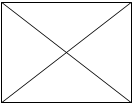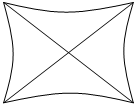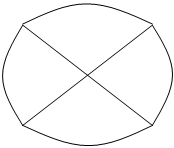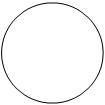This set of Mechanical Metallurgy Multiple Choice Questions & Answers (MCQs) focuses on “Meyer Hardness”.
1. The indenter used in the Vicker’s hardness tester is _______________
a) steel ball with 1.6 mm diameter
b) steel ball with 10mm diameter
c) square-base diamond pyramid
d) square-base flat-pyramid
View Answer
Explanation: The Vickers’s hardness uses the square-based diamond pyramid as the indenter. The included angle between opposite faces of the pyramid is 136°.
2. The Vicker’s hardness number is given as _____________
a) P/L
b) P/L2
c) 1.854*P/L2
d) 1.854*P/L
View Answer
Explanation: The Hardness number is defined as the load divided by the surface area of indentation.
-> 2P sin(θ/2)/L2; Where the θ is the angle between the diagonals equal to 136°, P-load, L-Average length of diagonal.
-> 1.854*P/L2
3. In the case of Vicker’s hardness measurement, the softer material will have a higher hardness number, and harder material will have lower VHN.
a) True
b) False
View Answer
Explanation: The Vicker’s hardness is defined by:
-> 1.854*P/L2
So for a given load, the softer material will have higher diameter values, and VHN will be lower and vice versa for the harder stuff.
4. Which one of the following represents the cold-worked material for diamond pyramid indentation impression geometry?
a)

b)

c)

d)

View Answer
Explanation: The perfect indentation will look like this;

So, if the material is very soft, the material will protrude after deformation. If very hard, it will bulge out of the edges, causing the burring of the shape.
5. The most widely used hardness method is ______________
a) Rockwell
b) Knoop
c) Vicker’s
d) Brinell
View Answer
Explanation: The Rockwell hardness measurement is the most widely used method; it is very fast to get the result and can be used on all types of material by slightly changing the probe and the load.
6. The minor load in the Rockwell hardness measurement is generally equal to ___________
a) 50 kg
b) 150 kg
c) 10 kg
d) 20 kg
View Answer
Explanation: The minor load is to set the sample on the base of the specimen mounting unit. Once the minor load of 10 kg is applied, then the major load of either 100 kg or 150 kg can be applied.
7. The Rockwell hardness number unit is equal to __________
a) kg/mm2
b) kg/mm
c) kg-mm2
d) unit less
View Answer
Explanation: The Rockwell hardness number is an arbitrary unit number that measures the depth of the indentation on the dial.
8. The Rockwell hardness scale is divided into 100 equal division, with each division representing a depth of __________
a) 0.002 mm
b) 0.001 mm
c) 0.01 mm
d) 1 mm
View Answer
Explanation: The dial scale is divided into 100 division of 0.002 mm depth each. The high hardness material shows less depth of indentation and vice versa.
9. The Brale indenter is used for which hardness measurement method?
a) Vicker’s
b) Rockwell
c) Knoop
d) Microhardness
View Answer
Explanation: The Brale indenter is a 120° diamond cone shape with a slightly rounded point. Other than the brale indenter, the other indenter used are 1.6 mm and 3.2 mm diameters steel balls.
10. If the material is showing a hardness value of HRc 57, which of the following combination of load and indenter is used for the measurement?
a) Load-100 kg, indenter-diamond cone
b) Load-150 kg, indenter-diamond cone
c) Load-100 kg, indenter-1.6 mm diameter ball
d) Load-150 kg, indenter-1.6 mm diameter steel ball
View Answer
Explanation: The Rockwell C scale is used for tough materials. So the major load of 150 kg is applied, and diamond cone indenter is used.
11. The HRB scale of Rockwell hardness measurement range from _________
a) 0-100
b) 0-50
c) 20-70
d) 50-150
View Answer
Explanation: The HRB scale has a major load of 100 kg and is used for major steel, copper, etc. The 1.6 mm diameter steel ball is used as indenter. The range is from 0-100.
Sanfoundry Global Education & Learning Series – Mechanical Metallurgy.
To practice all areas of Mechanical Metallurgy, here is complete set of 1000+ Multiple Choice Questions and Answers.
If you find a mistake in question / option / answer, kindly take a screenshot and email to [email protected]
- Apply for Metallurgical Engineering Internship
- Check Metallurgical Engineering Books
- Check Mechanical Metallurgy Books
- Practice Metallurgical Engineering MCQs
